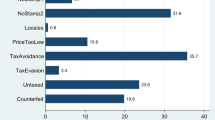Abstract
Utilizing published ratings of state-level antismoking laws, this paper addresses the merits of limits to smoking in public places and restrictions on youth access to tobacco. Consistent with the literature, we find that clean indoor-air laws reduce demand. However, by failing to address supply considerations, the literature to date presents a biased reaction of consumption to antismoking laws. Indeed, we find that clean indoor-air laws also intensify competition, which suggests that producers mitigate demand reductions by lowering price. Nonetheless, restrictions to youth access, as well as enforcement and penalty efforts, have little impact on cigarette consumption across states.
Similar content being viewed by others
References
Alciati, M., M. Frosh, S. Green, R. Brownson, P. Fisher, R. Hobart, A. Roman, R. Sciandra, and D. Shelton. 1998. “State Laws on Youth Access to Tobacco in the United States: Measuring Their Extensiveness with a New Rating System.”Tobacco Control 7: 345–352.
Arnade, C., D. Pick, and M. Gopinath. 1998. “Testing Oligopoly Power in Domestic and Export Markets.”Applied Economics 30: 753–760.
Bagwell, K., and R. Staiger. 1997. “Collusion over the Business Cycle.”Rand Journal of Economics 28: 82–106.
Baltagi, B., and D. Levin. 1986. “Estimating the Dynamic Demand for Cigarettes Using Panel Data: The Effects of Bootlegging, Taxation, and Advertising Reconsidered.”Review of Economics and Statistics 68: 148–155.
Baltagi, B., J. Griffin, and W. Xiong. 2000. “To Pool or Not to Pool: Homogeneous versus Heterogeneous Estimators Applied to Cigarette Demand.”Review of Economics and Statistics 82: 117–126.
Barnett, P., T. Keeler, and T. Hu. 1995. “Oligopoly Structure and the Incidence of Cigarette Excise Taxes.”Journal of Public Economics 57: 457–470.
Bartelsman, E., R. Becker, and W. Gray. 2000 “NBER-CES Manufacturing Industry Database. Washington, DC: Bureau of Economic Research.
Bresnahan, T. 1989. “Empirical Studies of Industries with Market Power.” InHandbook of Industrial Organization, edited by R. Schmalensee and R. Willig. Amsterdam: Elsevier Science Publishers.
Chaloupka, F., and H. Saffer. 1992. “Clean Indoor Air Laws and the Demand for Cigarettes.”Contemporary Economic Policy 10: 72–83.
Chaloupka, F., and M. Grossman. 1996. “Price, Tobacco Control Policies, and Youth Smoking.” NBER Working Paper (#5740).
Chaloupka, F., J. Taurus, and M. Grossman. 1997. “Public Policy and Youth Smokeless Tobacco Use.”Southern Economic Journal 64: 503–516.
Chriqui, J., M. Frosh, R. Brownson, D. Shelton, R. Sciandra, R. Hobart, P. Fisher, R. Arculi, and M. Alciati. 2002. “Application of a Rating System to State Clean Indoor Air Laws (USA).”Tobacco Control 11: 26–34.
Council of Economic Advisors. 1999.Economic Report of the President. Washington, DC.
Eckard, E. 1991. “Competition and the TV Advertising Ban.”Economic Inquiry 29: 119–133.
Farr, S., C. Tremblay, and V. Tremblay. 2001. “The Welfare Effect of Advertising Restrictions in the U.S. Cigarette Industry.”Review of Industrial Organization 18: 147–160.
Federal Trade Commission. 1998.Report to Congress Pursuant to the Federal Cigarette Labeling and Advertising Act, Washington, DC.
Fujii, E. 1980. “The Demand for Cigarettes: Further Empirical Evidence and Its Implications for Public Policy.”Applied Economics 12: 479–489.
Gallet, C. 2003. “Advertising and Restrictions in the Cigarette Industry: Evidence of State-by-State Variation.”Contemporary Economic Policy 21: 338–348.
Gallet, C., and J. List. 2003. “Cigarette Demand: A Meta-Analysis of Elasticities.”Health Economics 12: 821–835.
Haltiwanger, J., and J. Harrington. 1991. “The Impact of Cyclical Demand Movements on Collusive Behavior.”Rand Journal of Economics 22: 89–106.
Hamilton, J. 1972. “The Demand for Cigarettes: Advertising, the Health Scare, and the Cigarette Advertising Ban.”Review of Economics and Statistics 54: 401–411.
Kao, K., and V. Tremblay. 1988. “Cigarette Health Scare, Excise Taxes, and Advertising Ban: Comment.”Southern Economic Journal 54: 770–775.
Keeler, T., T. Hu, P. Barnett, and W. Manning. 1993. “Taxation, Regulation, and Addiction: A Demand Function for Cigarettes Based on Time-Series Evidence.”Journal of Health Economics 12: 1–18.
Keeler, T., T. Hu, P. Barnett, W. Manning, and H. Sung. 1996. “Do Cigarette Producers Price-Discriminate by State? An Empirical Analysis of Local Cigarette Pricing and Taxation.”Journal of Health Economics 15: 499–512.
Mitchell, M., and J. Mulherin. 1988. “Finessing the Political System: The Cigarette Advertising Ban.”Southern Economic Journal 54: 855–862.
Ross, H., and F. Chaloupka. 2003. “The Effect of Cigarette Prices on Youth Smoking.”Health Economics 12: 217–230.
Rotemberg, J., and G. Saloner. 1986. “A Supergame-Theoretic Model of Price Wars during Booms.”American Economic Review 76: 390–407.
Seldon, B., and K. Doroodian. 1989. “A Simultaneous Model of Cigarette Advertising: Effects on Demand and Industry Response to Public Policy.”Review of Economics and Statistics 71: 673–677.
Tobacco Institute. 1998.The Tax Burden on Tobacco. Washington, DC.
Tremblay, C., and V. Tremblay. 1995. “The Impact of Cigarette Advertising on Consumer Surplus, Profit, and Social Welfare.”Contemporary Economic Policy 13: 113–124.
Warner, K. 1977. “The Effect of the Anti-Smoking Campaign on Cigarette Consumption.”American Journal of Public Health 67: 645–650.
Wasserman, J., W. Manning, J. Newhouse, and J. Winkler. 1991. “The Effects of Excise Taxes and Regulations on Cigarette Smoking.”Journal of Health Economics 10: 43–64.
Yurekli, A., and P. Zhang. 2000. “The Impact of Clean Indoor-Air Laws and Cigarette Smuggling on Demand for Cigarettes: An Empirical Model.”Health Economics 9: 159–170.
Author information
Authors and Affiliations
Rights and permissions
About this article
Cite this article
Gallet, C.A. The efficacy of state-level antismoking laws: Demand and supply considerations. J Econ Finan 28, 404–412 (2004). https://doi.org/10.1007/BF02751742
Issue Date:
DOI: https://doi.org/10.1007/BF02751742




